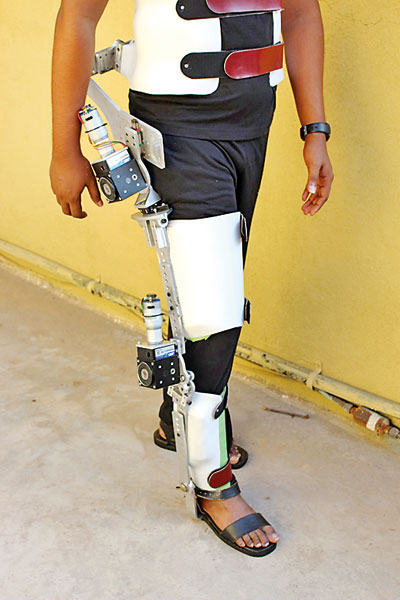SL’s first functional Lower Extremity Exoskeleton Robot to help the needy
Several decades of civil war has affected the socio-economic development of Sri Lanka and the country is currently in the rebuilding process. In that context, Department of Mechanical Engineering of University of Moratuwa believes that it is its duty to boost this process through technological innovation. In particular, the department is focused in providing suitable solutions to war victims and the needy to improve their quality of life by providing assistive technologies to carry out their activities of daily living.
Leading the way, the Bionics Laboratory of Department of Mechanical Engineering, University of Moratuwa started research on developing lower extremity exoskeleton robots. After the developments of two previous versions, it has now developed a functional lower extremity exoskeleton robot known as ‘Anthro-X’, a first for Sri Lanka.
The robot is a wearable device that combines human intelligence with machine power to perform intended movements of lower limbs. It is worn on the lower limbs and is attached to the hip, thigh, shank and foot segments. It is meant for providing power assistance to the legs of differently able-bodied users such as the elderly suffering from muscle deterioration and/or to carry out rehabilitation exercises on patients affected by neurological disorders.
At present, various research organisations around the globe are developing similar technologies to improve the living standard of physically incapacitated population.
However, Sri Lankans lack accessibility for such state-of-the-art solutions and services which are quick expensive. As an outcome of the design/research project completed last year, the team successfully laid the foundation for developing lower extremity exoskeleton robots for local use.
Anthro-x is derived from the terms ‘Anthropomorphic Exoskeleton’, meaning that the articulated mechanisms of the robot are well capable of conforming to the biological joints and limbs. Hence, it possesses superior kinematic compliance over the other exoskeleton technologies available in the international market. A human lower limb has seven major degrees of freedom (DoF) including three at hip joint, one at knee joint, and three at ankle joint. If movement of these DoF is inhibited, the natural movement patterns can get restricted. This may cause increase of metabolic energetic expenditure and at worst result in injuries to the musculoskeletal system.
Alternatively, Anthro-X supports all three DoF at the hip joint using a novel articulated structure. The moving axis of the knee joint is also mapped accurately using a newly introduced mechanism based on four-bar linkage system. The lightweight and ergonomically friendly robot only weighs 15 kg which is comparable with other world renowned alternatives. In addition, the design of Anthro-X is modular, meaning that it can be readily customized to suit users with wider range of requirements. It can be rearranged to support either the entire lower extremity or a selected joint such as hip or knee separately.
In the first phase of development, the feasibility and performance of Anthro-X was evaluated using healthy human subjects. In the second phase, a suitable candidate will be selected to perform rehabilitation exercises.
The project has been carried out by Mechanical Engineering undergraduates Tharindu Jayasiri, Dineth Tharaka, Hirun Gunasiri under the guidance of senior lecturers of the Department of Mechanical Engineering, University of Moratuwa – Dr. Ruwan Gopura and Eng. Pubudu Ranaweera. Anthro-X was successfully demonstrated at the EXMO 2017 exhibition held on April 28-29 at the department premises. The developers plan to further improve the functionality of Anthro-X and carry out clinical testing.


